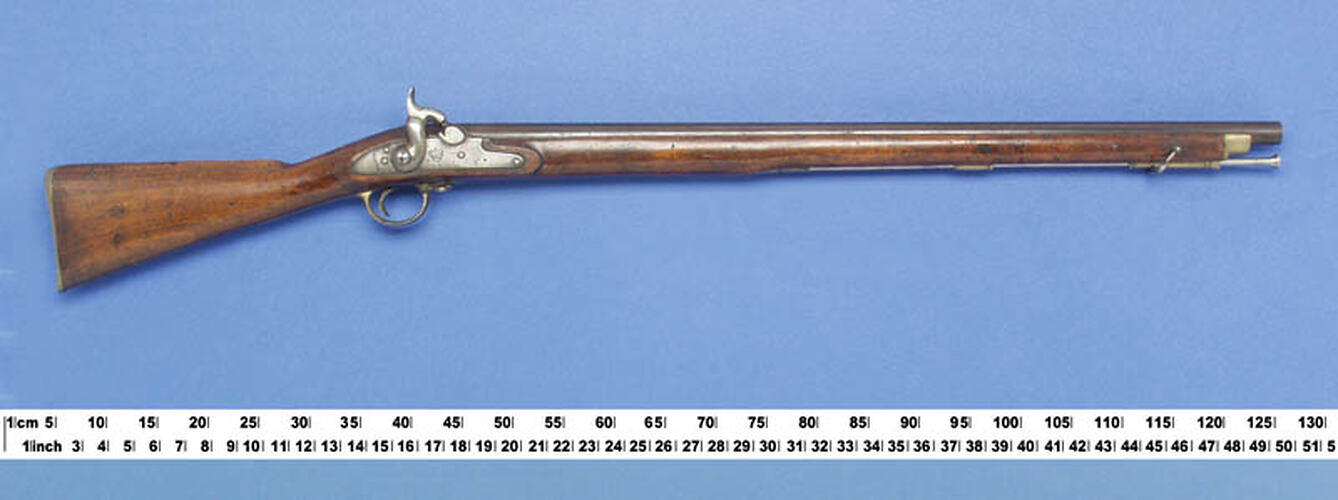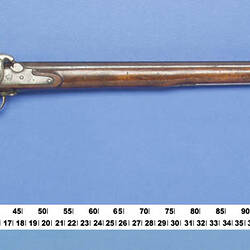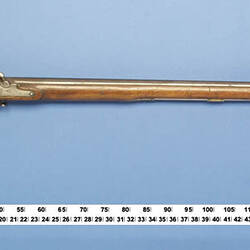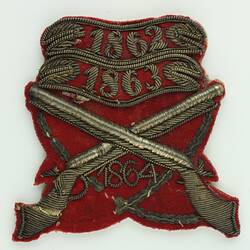Summary
British Service percussion musket, Pattern 1839 Musket converted to carbine, cal. .753 in., steel smoothbore round barrel, 841 mm long.
it is believed that this item was originally a Pattern 1839 Musket that has been reconfigured to carbine proportions, possibly in a Colonial Armoury prior to its transfer to the Museum in 1871, though it is now shorter than a manufactured carbine model.
One of 26 guns donated in 1871 by the Victorian Ordnance Department from its Melbourne Armoury, for the newly created Industrial and Technological Museum. The display was intended to show mechanics and gunsmiths the principles of gun construction and recent technical developments in weapons.
Physical Description
Steel lock and hammer on R.H. side, converted from flintlock, brass oval triggerguard with small front spur, brass New Land pattern sideplate, foreend and butt plate, two sling swivels, one mounted from triggerguard, the other above front ramrod tube. Missing foresight, no rear sight, barrel fastened to stock via three barrel pins, steel ramrod and three brass ramrod tubes, the front one being trumpet shaped. Ordnance marks stamped on underside of stock near triggerguard. Lock and barrel not removed for inspection on this date (31/8/05). Barrel L.H.side stamped with various British proof marks; Georgian proof of a crown over 'GR' over a broad arrow (c.1815 - c.1830), and goverment proof of a crown over crossed sceptres marks.
Significance
The decision in October 1838 to produce 30,000 flintlock muskets to alleviate a shortage of arms in the governments stores until percussion arms were available was amended only eight months later to bring the percussion arms into service using the parts already available, resulting in the Pattern 1839 Musket. Often perhaps incorrectly referred to as a 'conversion' firearms from flintlock to percussion, many examples show the tell-tale signs of the lockplates originally being drilled for flintlock mechanisms before being 'plugged' and the percussion system installed. This item appears to be an example of this practice, showing two plugged holes in the lockplate and heavy filing to the front half of the lockplate. An interesting example of the beginning of rapid technological advancement in firearm ignition systems. As well as use by British garison troops, the Pattern 1839 was sent out for use by militian and volunteer troops.
More Information
-
Collecting Areas
-
Acquisition Information
Donation (Probable) from Melbourne Armoury, 24 Oct 1871
-
User
Victoria: Ordnance Branch, Melbourne, Greater Melbourne, Victoria, Australia, 1840s-1860s
-
Inscriptions
Stamped on lockplate: TOWER, crown over 'VR', crown over government broad arrow Stamped on stock underside: CUTLER & SON Stamped on stock underside with ordnance marks Stamped on stock R.H.side: broad arrow over 'BO' (Board of Ordnance) Stamped on stock L.H.side: 83, S O Stamped on barrel with Georgian, and government proofmarks
-
Model Name or Number
-
Brand Names
-
Classification
-
Category
-
Discipline
-
Type of item
-
Overall Dimensions
124.5 cm (Length), 6.8 cm (Width), 20.5 cm (Height)
Barrel length: 84.10cm
-
References
[Book] Penrose, Edgar H. 1949. Descriptive Catalogue of the Collection of Firearms in the Museum of Applied Science of Victoria. 161. 14.
-
Keywords
Rifles & Muskets: British, Rifles & Muskets: Military, Victorian Colonial Defence Forces




